
Web: lenagh.nl
Instagram: @expatmaddi
Originally born and raised in the United States, Madeleine has lived in the Netherlands since 1970. At the present, she is near Haarlem and the North Sea coast. Madeleine is primarily a landscape photographer who looks for beauty in the simple and mundane. She joined Nature First in 2019, distressed by the damage her fellow photographers cause to the landscape and to wildlife and their habitats.
How old were you when you first discovered your love of nature? What prompted this?
As long as I can remember, my parents took us out on long rambles in the woods behind our Connecticut home. And on summer holidays, we would go camping on the Maine coast. My mother was a lover of birds and wildflowers, and a consummate shell and rock collector. She also never went anywhere without her 1953 Leica rangefinder camera.
How long have you been a photographer? What got you interested in photography?
I think photography was embedded in my DNA. My grandfather took photos in the 1920s. As I mentioned, my mother was also fanatic about photography (and all visual arts). I got my first camera (a Zeiss Ikon twin lens reflex) when I turned eighteen. When I came to the Netherlands, I married a professional photographer, which I found very intimidating. So, for many years, it remained a hobby on the side. It was not until I retired in 2012 that I dove into it with a passion
What led you to become active in Nature First?
I ran across the mention of Nature First in 2019. It seemed to be the first organisation for photographers interested in nature conservancy that accepted all photographers no matter what their level of accomplishment is. That inspired me, and I signed up. Shortly after, a Dutch ambassador contacted me and asked me if I was willing to help translate the English website into Dutch. And one thing led to another…
What kind of behavior distresses you the most? Do you have an example of this? How would you tie this into the Nature First principles?
Really, it all comes down to photographers wanting to get the shot no matter what the consequences are for the environment. And I do not understand trends in nature photography. What is the sense of drawing up bucket lists of subjects and locations that everyone photographs? Does that make you a better photographer?
If you had a magic wand that teleported you anywhere, where would you be taking pictures now? Why there?
I must admit that my urge to travel everywhere has diminished in recent years as I grow increasingly aware of the damage my wanderlust can cause to the environment. With a few exceptions, I try to at least limit my range to Europe. Besides Antarctica (an old dream of mine that will come true in 2024), the exceptions are family-related: a brother on the Washington coast and a sister in New Zealand. I’ve been to New Zealand several times now, and it is a photographer’s paradise!
If we were to have a bite to eat together, what would we be likely to talk about besides photography and Nature First?
Well, I would probably bore you to death with stories about my two amazing sons, my grandchildren, and my two Siberian Forest Cats. And whatever ‘project’ I’ve taken up. My most recent project was baking sourdough bread, which was curtailed by moving to a house with a less user-friendly kitchen, but I’m sure I’ll be diving into something new soon.
A picture you would like to share with us that has a history related to our principles, with a short text describing it.

One of the most distressing local examples of how photographers destroy the things they love is the tiny tree frog, which is red-listed as highly endangered. They thrive on bramble bushes, which should give them ample protection. Unfortunately, they are such popular subjects that photographers go trampling through the brambles, destroying half the habitat and probably half the tree frogs as well in their attempt to get the ‘perfect tree frog shot.’ And workshop leaders will even go as far as to cut paths through the brambles so their members can all get sufficient access.
I would say that all the Nature First principles tie into this example. I could probably draft a whole essay on this but will suffice by saying that this is not prioritising the well-being of nature over photography in any way.
